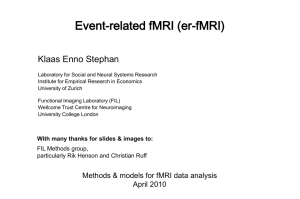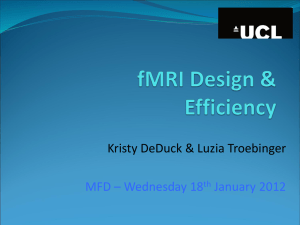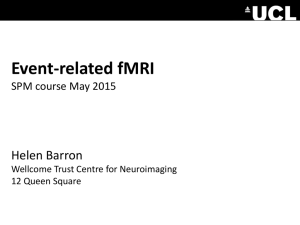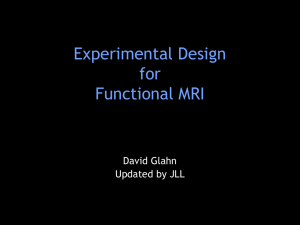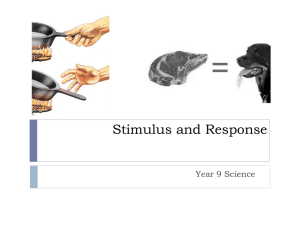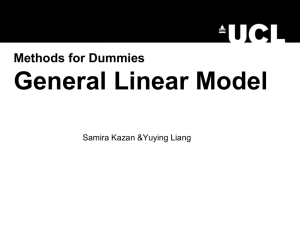Event-related fMRI and design efficiency
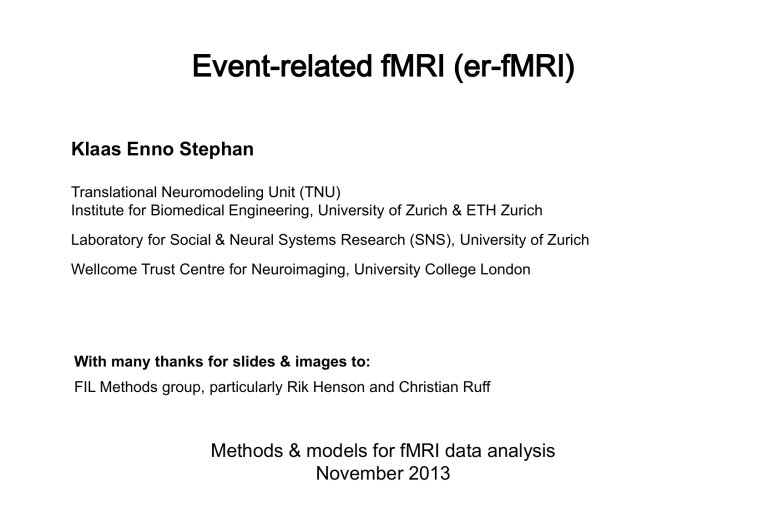
Event-related fMRI (er-fMRI)
Klaas Enno Stephan
Translational Neuromodeling Unit (TNU)
Institute for Biomedical Engineering, University of Zurich & ETH Zurich
Laboratory for Social & Neural Systems Research (SNS), University of Zurich
Wellcome Trust Centre for Neuroimaging, University College London
With many thanks for slides & images to:
FIL Methods group, particularly Rik Henson and Christian Ruff
Methods & models for fMRI data analysis
November 2013
Image time-series Kernel
Overview of SPM
Statistical parametric map (SPM)
Design matrix
Realignment Smoothing General linear model
Normalisation
Template
Parameter estimates
Statistical inference
Gaussian field theory p <0.05
Overview
1. Advantages of er-fMRI
2. BOLD impulse response
3. General Linear Model
4. Temporal basis functions
5. Timing issues
6. Design optimisation
7. Nonlinearities at short SOAs
Advantages of er-fMRI
1. Randomised trial order c.f. confounds of blocked designs
er-fMRI: Stimulus randomisation
Blocked designs may trigger expectations and cognitive sets
…
Unpleasant (U) Pleasant (P)
Intermixed designs can minimise this by stimulus randomisation
Pleasant
(P)
… … …
Unpleasant (U) Unpleasant (U) Pleasant
(P)
…
Unpleasant (U)
…
Advantages of er-fMRI
1. Randomised trial order c.f. confounds of blocked designs
2. Post hoc classification of trials e.g. according to performance or subsequent memory
er-fMRI: post-hoc classification of trials
Trial-wise response: item was or was not shown as picture.
Items with wrong memory of picture („hat“) were associated with more occipital activity at encoding than items with correct rejection
(„brain“)
Gonsalves & Paller (2000) Nature Neuroscience
Advantages of er-fMRI
1. Randomised trial order c.f. confounds of blocked designs
2. Post hoc classification of trials e.g. according to performance or subsequent memory
3. Some events can only be indicated by the subject e.g. spontaneous perceptual changes
er-fMRI: “on-line” event-definition
Bistable percepts
Binocular rivalry
Advantages of er-fMRI
1. Randomised trial order c.f. confounds of blocked designs
2. Post hoc classification of trials e.g. according to performance or subsequent memory
3. Some events can only be indicated by the subject e.g. spontaneous perceptual changes
4. Some trials cannot be blocked e.g. “oddball” designs
er-fMRI: “oddball” designs
…
Advantages of er-fMRI
1. Randomised trial order c.f. confounds of blocked designs
2. Post hoc classification of trials e.g. according to performance or subsequent memory
3. Some events can only be indicated by subject e.g. spontaneous perceptual changes
4. Some trials cannot be blocked e.g. “oddball” designs
5. More accurate models even for blocked designs?
er-fMRI: “event-based” model of block-designs
“Epoch” model assumes constant neural processes throughout block
U1 U2 U3
“Event” model may capture response better
P1 P2 P3
U1 U2 U3
P1 P2 P3
Data
Model
Modeling block designs: epochs vs events
• Designs can be blocked or intermixed,
BUT models for blocked designs can be epoch- or event-related
• Epochs are periods of sustained stimulation (e.g, box-car functions)
• Events are impulses (delta-functions)
• Near-identical regressors can be created by 1) sustained epochs, 2) rapid series of events (SOAs<~3s)
• In SPM, all conditions are specified in terms of their 1) onsets and 2) durations
… epochs: variable or constant duration
… events: zero duration
Sustained epoch
Series of events
“Classic”
Boxcar function
Delta functions
Convolved with HRF
Disadvantages of er-fMRI
1. Less efficient for detecting effects than blocked designs
(discussed in detail later).
2. Some psychological processes may be better blocked (e.g. task-switching, attentional instructions).
BOLD impulse response
• Function of blood volume and deoxyhemoglobin content (Buxton et al. 1998)
• Peak (max. oxygenation) 4-6s post-stimulus; return to baseline after 20-30s
• initial undershoot sometimes observed (Malonek & Grinvald,
1996)
• Similar across V1, A1, S1…
• … but differences across other regions (Schacter et al. 1997) and individuals (Aguirre et al. 1998)
Brief
Stimulus
Initial
Undershoot
Peak
Undershoot
BOLD impulse response
• Early er-fMRI studies used a long
Stimulus Onset Asynchrony
(SOA) to allow BOLD response to return to baseline.
• However, if the BOLD response is explicitly modelled, overlap between successive responses at short SOAs can be accommodated …
• … particularly if responses are assumed to superpose linearly.
• Short SOAs can give a more efficient design (see below).
Brief
Stimulus
Initial
Undershoot
Peak
Undershoot
General Linear (Convolution) Model u(t) h( t
)=
ß i f i
( t
)
For block designs, the exact shape of the convolution kernel (i.e. HRF) does not matter much.
For event-related designs this becomes much more important.
Usually, we use more than a single basis function to model the HRF.
GLM for a single voxel: y(t) = u(t)
h( t
) +
(t)
T 2T 3T ...
convolution sampled each scan
Design
Matrix
Temporal basis functions
Finite Impulse Response (FIR) model Fourier basis set
Gamma functions set
Informed basis set
Friston et al. 1998, NeuroImage
Informed basis set
Canonical
Temporal
Dispersion
• Canonical HRF:
• linear combination of 2 gamma functions
• 7 parameters, see spm_hrf
• plus Multivariate Taylor expansion in:
• time ( Temporal Derivative )
• width ( Dispersion Derivative; partial derivative of canonical HRF wrt. parameter controlling the width)
• F-tests: testing for responses of any shape.
• T-tests on canonical HRF alone (at 1 st level) can be improved by derivatives reducing residual error, and can be interpreted as
“amplitude” differences, assuming canonical
HRF is a reasonable fit.
Temporal basis sets: Which one?
In this example (rapid motor response to faces, Henson et al, 2001 )…
Canonical + Temporal + Dispersion
• canonical + temporal + dispersion derivatives appear sufficient
• may not be for more complex trials (e.g. stimulus-delay-response)
• but then such trials better modelled with separate neural components
(i.e. activity no longer delta function) (Zarahn, 1999)
+ FIR
left occipital cortex right occipital cortex
Penny et al. 2007, Hum. Brain Mapp.
Timing Issues : Practical
Scans
• Assume TR is 4s
• Sampling at [0,4,8,12…] post- stimulus may miss peak signal
TR=4s
Stimulus (synchronous)
Sampling rate=4s
SOA = Stimulus onset asynchrony
(= time between onsets of two subsequent stimuli)
Timing Issues : Practical
Scans
• Assume TR is 4s
• Sampling at [0,4,8,12…] post- stimulus may miss peak signal
• Higher effective sampling by:
– 1. Asynchrony, e.g. SOA = 1.5
TR
TR=4s
Stimulus (asynchronous)
Sampling rate=2s
SOA = Stimulus onset asynchrony
(= time between onsets of two subsequent stimuli)
Timing Issues : Practical
TR=4s
• Assume TR is 4s
• Sampling at [0,4,8,12…] post- stimulus may miss peak signal
• Higher effective sampling by:
– 1. Asynchrony, e.g. SOA = 1.5
TR
– 2. Random jitter, e.g. SOA = (2 ±
0.5)
TR
• Better response characterisation
(Miezin et al, 2000)
Scans
Stimulus (random jitter)
Sampling rate=2s
SOA = Stimulus onset asynchrony
(= time between onsets of two subsequent stimuli)
Slice-timing
Sladky et al. 2011, NeuroImage
Slice-timing
Top slice
• Slices acquired at different times, yet model is the same for all slices
=> different results (using canonical
HRF) for different reference slices
• Solutions:
1. Temporal interpolation of data
… but may be problematic for longer
TRs
2. More general basis set (e.g. with temporal derivatives)
… but more complicated design matrix
SPM{t}
Interpolated
Bottom slice
Derivative
SPM{t}
SPM{t}
TR=3s
Henson et al. 1999
SPM{F}
Slice-timing
Sladky et al. 2011, NeuroImage
Design efficiency
• The aim is to minimize the standard error of a t -contrast
(i.e. the denominator of a t-statistic).
var( c
T
ˆ
)
ˆ 2 c
T
( X
T
X )
1 c
• This is equivalent to maximizing the efficiency ε :
(
ˆ 2
, c , X )
(
ˆ 2 c
T
( X
T
X )
1 c )
1
T
c
T
ˆ var( c
T
ˆ
)
Noise variance Design variance
• If we assume that the noise variance is independent of the specific design:
( c , X )
( c
T
( X
T
X )
1 c )
1
NB: efficiency depends on design matrix and the chosen contrast !
• This is a relative measure: all we can say is that one design is more efficient than another (for a given contrast).
Stimulus (“Neural”)
Fixed SOA = 16s
HRF
=
Predicted Data
Not particularly efficient…
Stimulus (“Neural”)
Fixed SOA = 4s
HRF
=
Predicted Data
Very inefficient…
Stimulus (“Neural”)
Randomised, SOA min
= 4s
HRF Predicted Data
=
More efficient …
Stimulus (“Neural”)
Blocked, SOA min
= 4s
HRF
=
Predicted Data
Even more efficient…
Another perspective on efficiency
Hemodynamic transfer function
(based on canonical HRF) : neural activity (Hz) → BOLD
Highpass-filtered efficiency = bandpassed signal energy
Josephs & Henson 1999, Phil Trans B
Stimulus (“Neural”)
Blocked, epoch = 20s
HRF
=
Predicted Data
=
Blocked-epoch (with short SOA)
Sinusoidal modulation, f = 1/33s
Stimulus (“Neural”) HRF Predicted Data
=
=
The most efficient design of all!
Blocked (80s), SOA min
=4s, highpass filter = 1/120s
Stimulus (“Neural”) HRF
Predicted data
(incl. HP filtering!)
=
Don’t use long (>60s) blocks!
=
Randomised, SOA min
=4s, highpass filter = 1/120s
Stimulus (“Neural”) HRF Predicted Data
=
=
Randomised design spreads power over frequencies.
Efficiency: Multiple event types
• Design parametrised by:
SOA min
Minimum SOA p i
(h) Probability of event-type i given history h of last m events
Differential Effect (A-B)
• With n event-types p i
(h) is a n m
Transition Matrix
n
Common Effect (A+B)
• Example: Randomised AB
A
B
A
0.5
0.5
B
0.5
0.5
=> ABBBABAABABAAA...
4s smoothing; 1/60s highpass filtering
Efficiency: Multiple event types
• Example: Null events
A
A
0.33
B
0.33
B 0.33
0.33
=> AB-BAA--B---ABB...
• Efficient for differential and main effects at short SOA
• Equivalent to stochastic SOA (null event corresponds to a third unmodelled event-type)
Null Events (A-B)
Null Events (A+B)
4s smoothing; 1/60s highpass filtering
Nonlinearities at short SOAs stim. presented alone stim. when preceded by another stim. (1 s)
Friston et al. 2000, NeuroImage Friston et al. 1998, Magn. Res. Med.
Efficiency – main conclusions
• Optimal design for one contrast may not be optimal for another.
• Generally, blocked designs with short SOAs are the most efficient design.
• With randomised designs, optimal SOA for differential effect (A-B) is minimal SOA (assuming no saturation), whereas optimal SOA for common effect (A+B) is 16-20s.
• Inclusion of null events gives good efficiency for both common and differential effects at short SOAs.
Thank you
